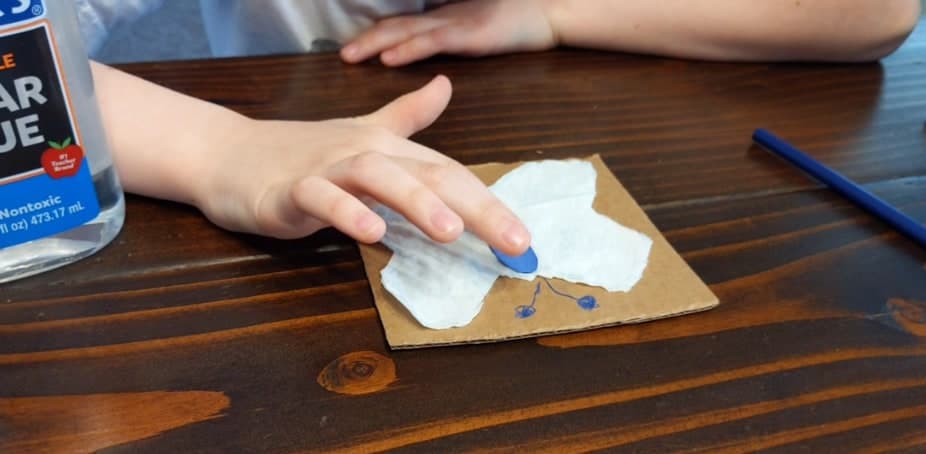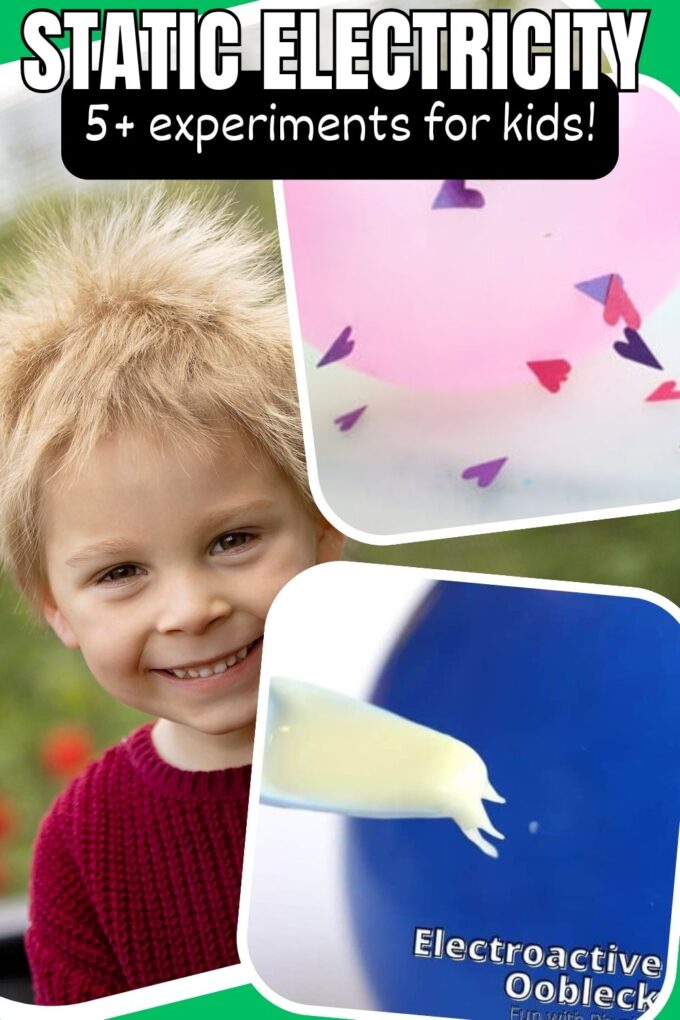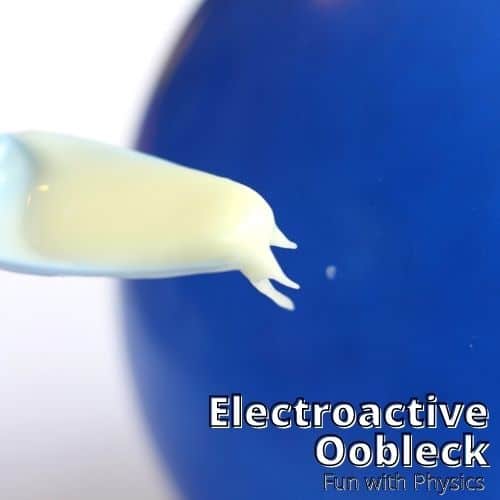

Six Fun Static Electricity Experiments for Science Students
Krystal DeVille
December 18, 2023

Electricity is a large part of our daily lives. Without it, we would be able to engage in any activities.
We often don’t know exactly how precious it is until we experience a power outage. Electricity doesn’t just involve currents- it also allows individuals to move, think and feel. We explore several different static electricity experiments that illustrate what this natural phenomenon can do.
Table of Contents
Experiments Using Static Electricity
Experiments using static are fun. When most people consider experiments using static electricity, then envision the one involving hair and a balloon. However, many additional experiments will amaze children of any age and can effectively also illustrate how physics and chemistry are used in creating illusions.
*Warning: These experiments may debunk some well-known magic tricks!
Before we get into all the static electricity experiments, be sure to grab my free eBook with over 25 STEM experiments for kids. For all my free downloads, check out this page here.

1. Static Electricity Butterfly

- Age: Elementary school
- Time: 15 minutes
- Difficulty Level: Easy
This experiment demonstrates how static electricity can move the wings on a tissue paper butterfly.
- Googly eyes
- Cardstock paper
- Tissue paper

Instructions:
- Begin by cutting a square piece of cardboard into a 7″x 7″ square.
- Draw butterfly wings on a piece of tissue with a pencil. Make sure that it is smaller than your square. Cut the butterfly out and place them on the cardboard piece without gluing it.
- Cut the body of the butterfly using cardstock. Once finished, glue it to the middle of the butterfly. Make sure it overlaps the cardboard to prevent the wings from flying off. The wings need to be loose to demonstrate the effects of static electricity.
- Glue googly eyes on the butterfly. You can use pipe cleaners for antennae if you would like.
- Blow up the balloon.
- Rub the balloon on your hair to provide a static (electrical charge). Hold the balloon to the top of the butterfly. It should be close to it but shouldn’t touch the butterfly. You should see the wings lower and raise as the balloon is moved closer and further in distance.

The Science Behind the Experiment
When a balloon is rubbed on hair, electrons form. Electrons go from the hair and are given to the balloon generating static. When a negatively charged balloon comes into close contact with positively charged tissue, they generate an attraction. The pull of the charged attraction enables the paper to move towards the balloon.
Static electricity experiments are fun to do. It incorporates both the principles of physics and chemistry into something very simple. It is the perfect way to engage any child in STEM education while teaching them that learning can indeed be fun.
2. Flying Bag Experiment

- Age: Any age
- Time: A few minutes
No, this isn’t done by using an updraft of air but with static electricity. This is what levitates the bag into the air.
- Light plastic bag
- Piece of material
- Plastic Rod
- Use the piece of cloth to run the plastic rod’s surface for 40 seconds.
- Flatten a plastic bag. Then rub the piece of fabric against the bag’s surface for 40 seconds.
- Release the bag and watch while it levitates in the air while the rod is waved below.
The fabric and rod become negatively charged after rubbing them together. Like charges are known to repel each other, so the bag appears to repel when the wand is waved.
My kids loved all the microscope activities we did hands-on in this article. It’s a great way of opening the world to what they can’t see!

3. Hovering Plates
- Age: Elementary School
Using magnets is not the only way that items can repel each other. Hovering plates illustrates this concept very well.
- 2 Styrofoam plates
- Piece of fabric, or your shirt
- Using the piece of fabric, rub the base of one plate.
- Put the plate (base up) on any flat surface.
- Attempt to place the other plate (base down) on top of the other plate. The two plates will repel each other.
This experiment works based on the principle of static electricity. This occurs when two things are rubbed together. The one plate receives electrons directly from the fabric and then becomes negatively charged. In turn, the electrons generated repel the other plate.
4. Bending Water Using Static Electricity

In nature, water can bend due to the moon exerting tidal forces. The same phenomenon can be accomplished by using static electricity.
- Running water
- Piece of cloth
- Plastic Rod or thick straw. My son used a smoothie straw like this because it’s thicker and works a little better.
- Use the fabric to rub the surface of the rod for 40 seconds.
- Create a stream of water by turning the tap on.
- Place the rod close to the water and watch with amazement as the stream bends.
This experiment can also be done using a comb. It would be best if you rubbed the comb against your hair for it to work. Then, you can use it to bend water.
Rubbing the material on the rod generates negatively charged ions. This repels the electrons found in the water. The water closest to the positioning of the rod receives positive charges from it. The attraction between positive and negative charges creates a force on the water, allowing it to appear as if it were bending.

5. Separating Pepper and Salt

Have you accidentally spilled both the salt and pepper? Here is a convenient way to separate them and sort through this lovely mess!
- Fabric or your shirt
- Thick straw
- Mix one teaspoon of pepper and salt thoroughly.
- Rub the straw on the fabric for 40 seconds.
- Place the straw over the mixture. The pepper should jump and adhere to the straw (if it’s held over the correct places).
The granules of pepper and salt are positively charged. As a result of gaining electrons directly from rubbing the cloth, the straw attracts these positive charges located in the mix. Since pepper is lighter, it will jump with greater ease to the straw.
6. Bubble Moving Balloon

This trick is fun and easy. It will delight young children and amaze older ones.
- Smooth sheet plastic, glass, or a kitchen plate like we used
- Dishwashing soap or bubble solution
- Charged balloon
- Spread the bubble solution on a sheet of glass or plastic. Blow larger bubbles on the sheet with the straw.
- Charge an object like a balloon.
- Place the object near the bubble and watch as they follow the charged object.
- Watch it move around the glass/plastic top.

Soapy water is drawn (attracted) to any object that is charged. When there is a large bubble, you can watch it move around.
Wrapping Up
I love static electricity experiments because they can be done with stuff you have lying around your house, not especially tools required. Our favorite experiment was the butterfly one. My three-year-old pretty much thought it was magic.
Another easy item to pick up is pop rocks. My kids had a great time with all the science experiments involving the cracking, popping treat in this article. Please check out our article, Fun Pop Rock Experiments Exploring Viscosity .

5 thoughts on “Six Fun Static Electricity Experiments for Science Students”
Great ideas here with materials that are readily available.
Thank you for ideas and a wonderful resource.
Kind Regards, Jan (Grandmother – Australia)
The salt and pepper experiment mentions a spoon in the directions, but it seems like it should be a straw according to the rest if the directions.
You’re right Kathryn, and thank you for pointing that out to me! The article has been updated 🙂
In the fourth one about bending water, one of the materials say ‘piece of clot’ not cloth. Just a minor error.
Thank you, good catch! I updated it.
Leave a Comment Cancel reply
Save my name, email, and website in this browser for the next time I comment.
most recent

Activities and Games , Toy Gift Guides
Best stem subscription boxes for kids: hands-on reviews.

STEM Holiday Deals , Product Reviews
Best black friday deals for sphero.

STEM Holiday Deals
Wonder workshop black friday deals (complete list of where and what to buy).

Product Reviews , Toy Gift Guides
Magna-tiles black friday deals: 2024.

Toy Gift Guides , Activities and Games , STEM Holiday Deals
Black friday stem toy deals 2024.

Activities and Games , Engineering
The young woodworkers kit club review (hands-on + coupon code).

Science , Activities and Games
Mel science review (hands-on + coupon code).
STEM Education Guide
[email protected] STEM Education Guide 9125 SVL BOX Victorville, CA 92395
Your Compass for STEM Discovery
© 2024 STEM Education Guide
Get Your ALL ACCESS Shop Pass here →

Static Electricity Experiments For Kids
Ever noticed how when you rub a balloon against your hair, it sticks to the wall? That’s static electricity in action! Learn more about this fun science concept with simple static electricity experiments, and everyday examples of static electricity. Enjoy hands-on physics experiments for kids!


Explore Static Electricity For Physics
Static electricity happens when tiny particles called electrons build up on an object, making it either positively or negatively charged.
When these charged objects get near each other, they can do some pretty cool things, like making your hair stand on end or attracting small things, like pieces of paper or confetti.
So, static electricity is all about the invisible forces that make objects stick together or repel each other, and it’s a fun and fascinating part of science that you can explore with simple static electricity experiments below.
💡For more ways to explore physics with kids, check out our list of easy physics experiments .
Examples of Static Electricity
Here are some everyday examples of static electricity that you can explain to kids. These examples help kids understand that static electricity is all around us, and it can be both fun and surprising when we see it in action. It’s like a little bit of science magic happening every day!
- Balloon on the Wall: When you rub a balloon against your hair and then stick it to the wall, it’s static electricity at work. The balloon becomes negatively charged from the friction, and it sticks to the wall, which has a different charge.
- Walking on Carpet: Sometimes, when you walk on a carpet with socks, you may feel a shock when you touch a metal doorknob. This happens because you build up a charge by rubbing against the carpet, and when you touch the doorknob, the charge flows and gives you a little shock.
- Socks and Jumping Beans: Sometimes, when you take off your socks after walking on a carpet, they might attract small items like jumping beans or bits of paper. The socks get charged as you walk, making them attract other small objects.
- Static Cling in the Dryer: When you take clothes out of the dryer, they might sometimes stick together or to the sides of the drum. This happens because of static electricity from the friction of the clothes rubbing against each other.
- Balloons Stick Together: If you rub two balloons against your hair and then bring them close together, they might stick to each other. This is because the like charges (both negatively charged) on the balloons repel each other.
- Crackling Sounds in the Winter: In cold, dry weather, you might hear crackling sounds when you touch things or take off your winter hat. That’s static electricity being discharged.
- Lightning: Explain how lightning during a thunderstorm is a massive example of static electricity in nature. It happens when negative charges build up in the clouds and discharge as a bright bolt of lightning to the ground.
- Petting a Cat or Dog: Sometimes, when you pet your cat or dog, you might feel a little shock when you touch their fur. It’s because of static electricity from friction between their fur and your hand.
Here are some simple and fun examples of static electricity experiments and demonstrations that are great for learning at home or in the classroom.
Rolling Can Static Electricity
The rolling can experiment provides a tangible demonstration of static electricity’s captivating nature! Grab a balloon and an aluminum can to get started.

Bending Water
Can you bend a stream of water with static electricity? It’s an easy and fun science demonstration for people of various ages to try.

Static Electricity with Balloons
Rub a balloon against your hair or a piece of wool cloth, and then place it near small pieces of paper. The paper should be attracted to the balloon, demonstrating the effect of static electricity. What happens when you use different types of cloth?

We’ve tested lightweight paper, tissue paper, and tinsel! What else can you test?

Static Electricity with a Plastic Straw
Rub a plastic straw with a piece of cloth or fur and then use it to pick up small pieces of paper or confetti. The static charge on the straw will make the paper pieces stick to it.
Static Electricity with a Plastic Bag
Inflate a plastic bag and rub it against your hair or a piece of fabric. Hold the bag near a wall, which should stick to the wall due to the static charge.
Static Electricity with a Balloon and Salt and Pepper
Rub a balloon against your hair and then bring it to a plate of salt and pepper. The salt and pepper will be attracted to the balloon, demonstrating the power of static electricity.
Static Electricity with a Comb and Water
Run a comb through your hair and bring it near a thin stream of water. The water will be attracted to the comb and bend towards it.
Check out the experiment details further below!
Static Electricity with Cornstarch Goop
Make electric goop ! Mix up a batch of cornstarch oobleck and test out the power of static electricity with a balloon.

What Is Static Electricity?
Think of tiny invisible particles called electrons as little magnets. Everything around us, like your hair, a balloon, or even a piece of cloth, is made up of these particles. Learn more about electrons here.
Sometimes, when two things rub against each other, like when you rub a balloon against your hair, the electrons can get all jumbled up and move from one thing to the other.
When this happens, one thing gets extra electrons, and the other thing loses some. The one with extra electrons becomes negatively charged, like a minus sign, and the one that lost some becomes positively charged, like a plus sign.
These opposite charges make things stick together or repel each other, like magnets with opposite ends.
So, when you rub the balloon on your hair, it’s taking some of your hair’s electrons, making the balloon negatively charged.
That’s why the balloon can stick to the wall or make your hair stand up—all because of those jumbled-up electrons creating static electricity. It’s like a tiny invisible magic show happening all around us!
Also Try: Static Electricity Butterfly
Make it fly! Harness the power of static electricity.
- Lightweight Paper/Tissue Paper
- Tape and Scissors
Instructions:
STEP 1: Cut out a butterfly shape from lightweight paper or tissue paper,
STEP 2: Attach a small piece of tape to its center and affix it to a straw.
STEP 3: Generate static electricity by rubbing a balloon against the fabric. Hold the charged balloon near the butterfly.
STEP 4: Observe as the butterfly flutters toward the balloon drawn by invisible forces!
Try This Static Electricity Experiment with a Comb
This comb and water static electricity experiment is a fun way to demonstrate the principles of static electricity to kids.
- A plastic comb (the type with fine teeth works well)
- A running faucet or a source of water
- A small piece of dry paper or a small piece of tissue
- A piece of dry cloth or wool (a piece of wool fabric or a wool sweater works great)
STEP 1. Take the dry comb and rub it vigorously against the dry cloth or wool for about 20-30 seconds. This rubbing creates a buildup of static electricity on the comb.
TIP: If the comb is not dry, be sure to dry it with a paper towel or cloth so that it’s completely free of water.
STEP 2. Have a running faucet nearby or fill a small sink with a shallow layer of water.
STEP 3. Now, while still holding the comb, bring it near the running faucet or the water surface without actually touching the water.
You should see that the water stream bends toward the comb, as if the comb is magically attracting the water.
TIP: You can also try this with a small piece of tissue instead of running water. When you bring the charged comb close to the tissue, you’ll notice that it’s attracted to the comb.
What is happening?
When you rub the comb against the cloth or wool, it picks up extra electrons and becomes negatively charged. The water or tissue has a positive charge.
Opposite charges attract, so the negatively charged comb attracts the positively charged water or tissue. This is a simple demonstration of the principles of static electricity.
Make sure to explain this concept to the kids while conducting the experiment, and encourage them to try it themselves. It’s a great way to make science fun and interactive for children.
Helpful Science Resources To Use
Here are a few resources that will help you introduce science more effectively to your kiddos or students and feel confident yourself when presenting materials. You’ll find helpful free printables throughout.
- Best Science Practices (as it relates to the scientific method)
- Science Vocabulary
- 8 Science Books for Kids
- All About Scientists
- Science Supplies List
- Science Tools for Kids
- Join us in the Club
More Physical Science Activities To Explore
- Gravity Experiments
- Magnet Activities
- Simple Machine Projects
- Potential & Kinetic Energy
- Light Experiments
- Surface Tension Experiments

Science Experiments By Age Group
We’ve put together a few separate resources for different age groups, but remember that many experiments will cross over and can be re-tried at several different age levels. Younger kiddos can enjoy the simplicity and hands-on fun. At the same time, you can talk back and forth about what is happening.
As kiddos get older, they can bring more complexity to the experiments, including using the scientific method , developing hypotheses, exploring variables , creating different tests, and writing conclusions from analyzing data.
- Science for Toddlers
- Science for Preschoolers
- Science for Kindergarten
- Elementary Science by Season
- Science for 1st Grade
- Science for 2nd Grade
- Science for 3rd Grade
- Science for 4th Grade
- Science for 6th Grade
- Science for Middle School
Printable Science Projects For Kids
If you’re looking to grab all of our printable science projects in one convenient place plus exclusive worksheets and bonuses like a STEAM Project pack, our Science Project Pack is what you need! Over 300+ Pages!
- 90+ classic science activities with journal pages, supply lists, set up and process, and science information. NEW! Activity-specific observation pages!
- Best science practices posters and our original science method process folders for extra alternatives!
- Be a Collector activities pack introduces kids to the world of making collections through the eyes of a scientist. What will they collect first?
- Know the Words Science vocabulary pack includes flashcards, crosswords, and word searches that illuminate keywords in the experiments!
- My science journal writing prompts explore what it means to be a scientist!!
- Bonus STEAM Project Pack: Art meets science with doable projects!
- Bonus Quick Grab Packs for Biology, Earth Science, Chemistry, and Physics

Subscribe to receive a free 5-Day STEM Challenge Guide
~ projects to try now ~.


IMAGES
VIDEO